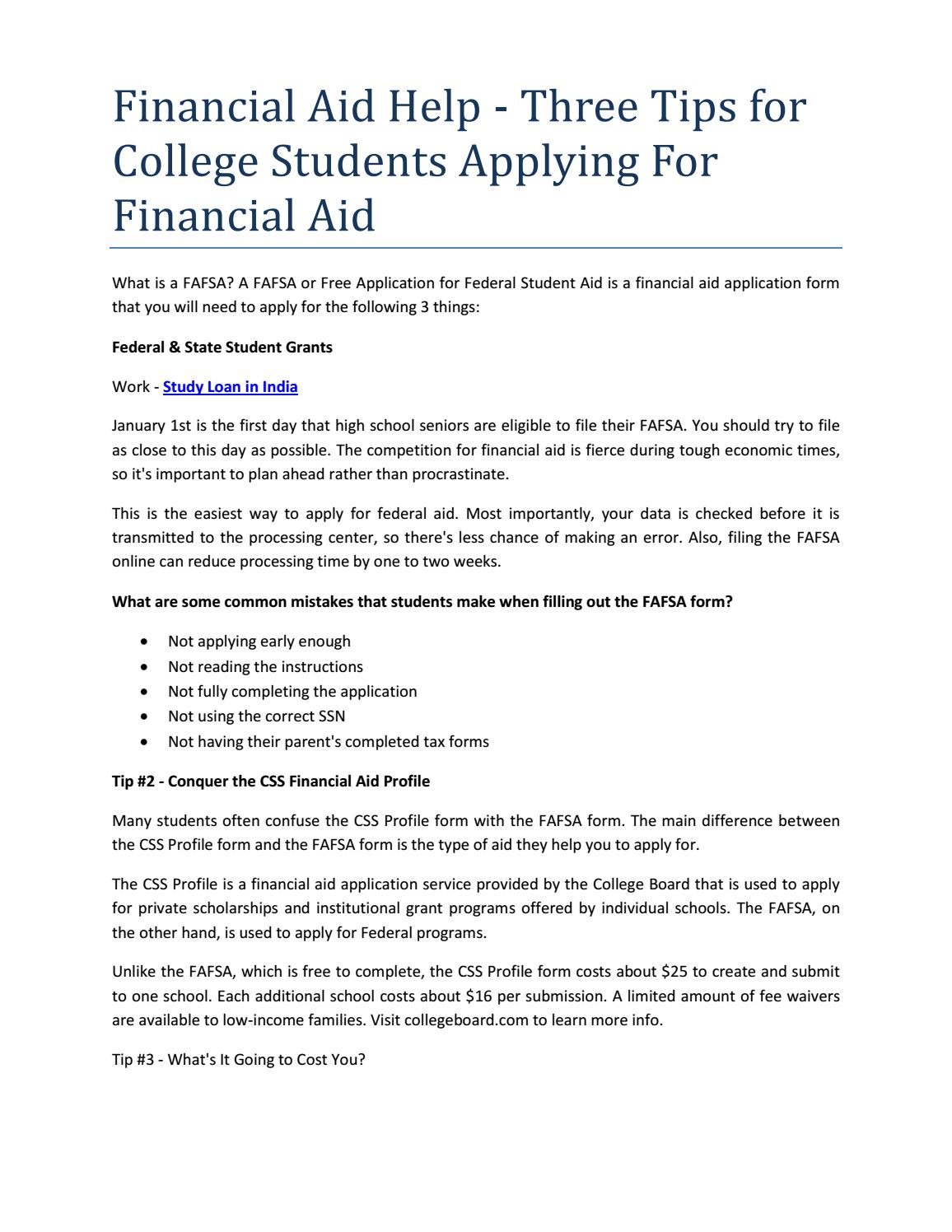Applying for financial aid for college can be a daunting task. But fear not! We’ve got you covered. In this comprehensive guide, we will walk you through the process of how to apply for financial aid for college, step by step. From understanding the different types of aid available to filling out the Free Application for Federal Student Aid (FAFSA), we’ll provide all the information you need to navigate the world of financial assistance. So, if you’re wondering how to apply for financial aid for college, look no further! Let’s dive in and get you on your way to securing the funds you need for your education.
How to Apply for Financial Aid for College
Introduction
Applying for financial aid can be a crucial step in making higher education more accessible and affordable for students. College tuition fees can be overwhelming, but through financial aid programs, students can receive assistance in the form of grants, scholarships, work-study programs, and loans. This comprehensive guide will walk you through the process of applying for financial aid, ensuring that you have the necessary information to make informed decisions and maximize your opportunities.
Step 1: Gather Information and Documents
Before diving into the financial aid application process, it’s important to gather all the necessary information and documents. This includes:
– Social Security number or Individual Taxpayer Identification Number (ITIN)
– Federal Income Tax Returns (and parents’ tax returns if applicable)
– W-2 forms or other records of income
– Bank statements and investment records
– Records of untaxed income
– Alien registration number (if not a U.S. citizen)
Having this information readily available will streamline the application process and ensure that you provide accurate and complete information.
Step 2: Submit the Free Application for Federal Student Aid (FAFSA)
The Free Application for Federal Student Aid (FAFSA) is the starting point for accessing federal financial aid. It determines your eligibility for grants, scholarships, work-study, and federal student loans. Follow these steps to complete the FAFSA:
1. Create an FSA ID: The FSA ID is a unique username and password that you’ll use to access and sign the FAFSA. Both the student and one parent (if applicable) will need an FSA ID.
2. Complete the FAFSA online: Visit the official FAFSA website and follow the step-by-step instructions to complete the application. Ensure that all information is accurate and up-to-date.
3. Use the IRS Data Retrieval Tool (DRT): If eligible, use the DRT to import your tax information directly from the IRS into the FAFSA. This simplifies the process and reduces the chances of errors.
4. Review and Submit: Carefully review all provided information and make any necessary corrections. Once satisfied, submit the application. Remember to keep a copy for your records.
Step 3: Understand the Expected Family Contribution (EFC)
After submitting the FAFSA, you will receive a Student Aid Report (SAR) which includes your Expected Family Contribution (EFC). The EFC is the amount of money your family is expected to contribute towards your education expenses and is based on their financial situation. Understanding your EFC is crucial as it determines your eligibility for need-based financial aid.
Step 4: Research and Apply for Scholarships
In addition to federal financial aid, scholarships can greatly reduce the financial burden of college. Scholarships are typically awarded based on academic achievement, talent, community involvement, or other specific criteria. Here’s how to find and apply for scholarships:
1. Research scholarship opportunities: Utilize scholarship search engines, check with your high school counselor, explore local organizations, and research scholarships offered by colleges and universities.
2. Review eligibility criteria: Carefully read and understand the eligibility criteria for each scholarship. Focus on scholarships that match your academic performance, interests, or personal background.
3. Prepare application materials: Organize your academic records, recommendation letters, personal statement, and any other required documents. Tailor your application materials to each scholarship opportunity.
4. Submit applications: Pay attention to application deadlines and submit your applications before the specified date. Follow any instructions or additional requirements provided by scholarship organizations.
Step 5: Explore State and Institutional Aid Programs
Apart from federal financial aid and scholarships, many states and colleges offer their own financial aid programs. These programs may have specific eligibility criteria, application processes, and deadlines. Here are some key steps to follow:
1. Research state programs: Visit your state’s higher education agency website to explore the financial aid programs available. Pay attention to any state-specific deadlines and eligibility requirements.
2. Investigate institutional aid: Research the financial aid programs offered by the colleges or universities you are interested in attending. Many institutions provide grants, scholarships, and work-study opportunities for their students.
3. Contact financial aid offices: If you have specific questions or need further assistance, reach out to the financial aid offices of the colleges you are applying to. They can provide guidance and help you navigate the application process.
Step 6: Review and Compare Financial Aid Offers
Once you start receiving financial aid offers from colleges, it’s important to review and compare them carefully. Consider the following factors:
– Grants and scholarships: These are free money and do not need to be repaid. Compare the amounts offered by different colleges.
– Work-Study programs: Evaluate the work-study opportunities available and determine if they align with your schedule and academic commitments.
– Loans: If you need to take out loans, compare the interest rates, repayment terms, and overall borrowing costs. Be cautious and borrow only what you need.
It’s crucial to understand the impact of each financial aid offer on your overall cost of education. Consider reaching out to the financial aid offices for clarification or additional information.
Step 7: Accept/Decline Financial Aid Offers and Complete Additional Requirements
After carefully reviewing and comparing financial aid offers, you will need to accept or decline the offers from each college. Additionally, you may have to complete any additional requirements, such as signing promissory notes for loans or attending orientation programs. Follow the instructions provided by each college to ensure a smooth process.
Step 8: Maintain Eligibility and Renew Financial Aid
Financial aid is often renewable for subsequent years of college, but you must maintain eligibility. Here are some tips to maintain and renew your financial aid:
– Maintain satisfactory academic progress: Meet the minimum GPA requirements and successfully complete the required number of credit hours each semester.
– File the FAFSA annually: Complete the FAFSA for each academic year to ensure you are considered for all available financial aid.
– Understand renewal requirements: Familiarize yourself with any additional renewal requirements imposed by the financial aid programs you are receiving assistance from.
– Stay in touch with the financial aid office: If you encounter any changes in your financial situation or have questions about renewing your financial aid, reach out to the financial aid office for guidance.
Applying for financial aid for college may seem like a complex process, but with proper guidance and preparation, it can become more manageable. By following the steps outlined in this guide, you will be equipped with the knowledge and resources needed to navigate the financial aid application process and make informed decisions. Remember, financial aid opens doors to educational opportunities, so don’t hesitate to explore the options available to you. Start early, be thorough, and take advantage of the financial aid options that can make your college dreams a reality.
how to fill out the FAFSA and maximize aid (step-by-step guide)
Frequently Asked Questions
Frequently Asked Questions (FAQs)
How do I apply for financial aid for college?
To apply for financial aid for college, you need to follow these steps:
1. Complete the Free Application for Federal Student Aid (FAFSA) form online.
2. Gather all necessary documents, such as tax returns and income information.
3. Submit the FAFSA form before the deadline.
4. Review your Student Aid Report (SAR) for any errors or corrections.
5. Receive and review financial aid award letters from colleges.
6. Choose the best financial aid package and accept the offer.
7. Complete any additional forms required by the college or scholarship programs.
8. Keep track of deadlines and respond promptly to any requests for information or documentation.
What is the deadline for applying for financial aid?
The deadline for applying for financial aid varies depending on the college or university you are applying to. It is important to check the specific deadline for each institution you are interested in. Generally, the FAFSA form becomes available on October 1st each year, and the deadline for state and federal aid is typically in the spring. However, some colleges have their own financial aid deadlines, which may be earlier than the federal deadline. It is best to submit your application as soon as possible to maximize your chances of receiving aid.
Do I need to pay to submit the FAFSA form?
No, the FAFSA form is free to submit. The acronym “Free” in its name stands for this reason. You should never pay to complete or submit the FAFSA. It is important to use the official FAFSA website (fafsa.ed.gov) to ensure you are not redirected to any fraudulent or misleading websites that may charge you for their services. The official FAFSA form can be completed and submitted online without any cost.
What documents do I need to complete the FAFSA form?
To complete the FAFSA form, you will need the following documents:
1. Social Security number or Alien Registration Number.
2. Federal income tax returns, W-2s, and other records of money earned for yourself and your parents (if applicable).
3. Bank statements and records of investments, if applicable.
4. Records of untaxed income, such as child support or veterans benefits.
5. Any other information about your financial situation, such as mortgage or business assets.
Can I apply for financial aid if I am an international student?
International students are generally not eligible to receive federal financial aid in the United States. However, some colleges and universities offer scholarships or financial aid specifically for international students. It is best to check with the financial aid office of the institution you are interested in attending to determine what options may be available to you.
What is the difference between grants and loans?
Grants and loans are both types of financial aid, but they have different characteristics:
– Grants: Grants are typically awarded based on financial need and do not need to be repaid. They are essentially free money that you can use towards your college expenses.
– Loans: Loans, on the other hand, need to be repaid with interest. They are borrowed money that you will have to pay back after you graduate or leave college. Loans can be obtained from the government or private lenders.
How can I increase my chances of receiving financial aid?
To increase your chances of receiving financial aid, consider the following tips:
– Complete the FAFSA form accurately and on time.
– Research and apply for scholarships that you may be eligible for.
– Maintain good grades and academic performance.
– Demonstrate your involvement in extracurricular activities and community service.
– If your financial situation changes, contact the financial aid office to request a review of your aid package.
– Keep track of deadlines and submit all required documents promptly.
Can I apply for financial aid if I am attending part-time?
Yes, you can still apply for financial aid if you are attending college on a part-time basis. However, the amount of aid you are eligible to receive may be prorated based on the number of credits you are taking. It is important to check with the financial aid office of your institution to understand the specific policies and guidelines for part-time students.
Final Thoughts
Applying for financial aid for college is a crucial step in securing funding for your education. To begin the process, gather all necessary documents, such as tax returns and bank statements. Then, complete the Free Application for Federal Student Aid (FAFSA) form online, ensuring accuracy and completeness. Research and explore additional scholarship opportunities from organizations and institutions. Stay organized and keep track of deadlines. Finally, follow up with the financial aid office at your chosen college to confirm the status of your application. Remember, applying for financial aid for college is an essential part of making higher education more accessible and affordable.



